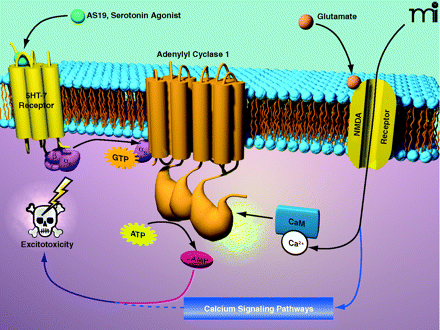
- Institution: Stanford Univ Med Ctr Lane Med Lib/Periodical Dept/Rm L109
- Sign In as Member / Individual
Adenylyl Cyclase Isoforms as Novel Therapeutic Targets: An Exciting Example of Excitotoxicity Neuroprotection

A model forN-methyl-D-aspartate receptor (NMDAR)-mediated excitotoxicity involving adenylyl cyclase type 1 (AC1). Activation of AC1 by the NMDA receptor (NMDAR), but not by the serotonin (5-hydroxytryptamine) subtype 7 receptor (5-HT7R), leads to excitotoxicity. Although the mechanism for excitotoxicity requires further study, the report by Wang et al. (1) suggests that glutamate activation of the NMDAR leads to excitotoxicity mediated through AC1, which appears to require involvement of additional Ca2+-modulated pathways (blue arrows). That is, activation of AC1 appears to be a necessary but not sufficient condition for excitotoxicity. AS19, a serotonin agonist; CaM, calmodulin; cAMP, cyclic AMP.


